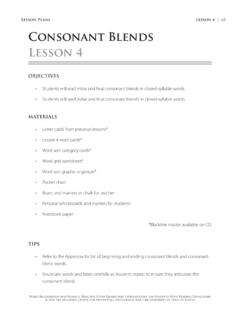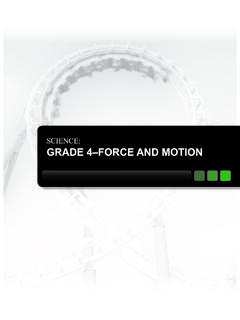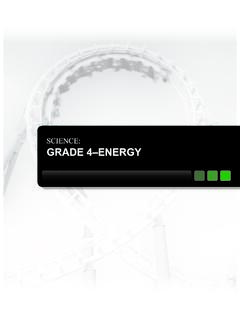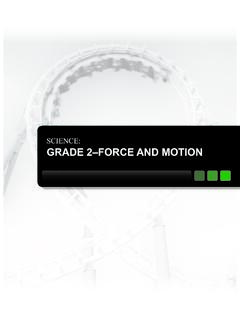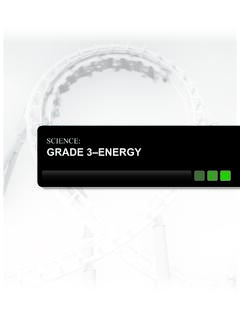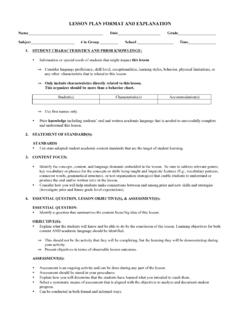Transcription of Lesson Plans Lesson 1 | Short Vowels Lesson 1
1 Word Recognition and Fluency: Effective Upper-Elementary Interventions for Students With Reading Difficulties 2010 The Meadows Center for Preventing Educational Risk, the University of Texas at AustinLesson Plans Lesson 1 | 11 Word Recognition and Fluency: Effective Upper-Elementary Interventions for Students With Reading Difficulties 2010 The Meadows Center for Preventing Educational Risk, the University of Texas at AustinShort VowelsLesson 1 OBJECTIVES Students will say the Short vowel sounds that correspond to specific Vowels . Students will identify the Vowels associated with specific Short vowel Lesson 1 letter cards (one set each for teacher and students)* Letter-sound practice worksheet* Colored pencils (blue, green, red) Picture worksheet* Timer Board and markers or chalk for teacher Personal whiteboards and markers for students Notebook paper*Blackline master available on Use key words when introducing Short vowel sounds for example, e, egg, /e/.
2 The following key words are suggested: a apple, e egg, i igloo, o octopus, and u up. Encourage students to refer back to the key word as a clue to the sound of the letter. Provide sufficient wait time for student responses. Establish a gesture or cue phrase ( , Ready? Go. ) for choral responses. Include previously taught sounds in the daily review and Lesson | Lesson 1 Lesson PlansWord Recognition and Fluency: Effective Upper-Elementary Interventions for Students With Reading Difficulties 2010 The Meadows Center for Preventing Educational Risk, the University of Texas at AustinWord Recognition and Fluency: Effective Upper-Elementary Interventions for Students With Reading Difficulties 2010 The Meadows Center for Preventing Educational Risk, the University of Texas at Austin Include activities that provide students with practice discriminating among previously taught vowel sounds.
3 Do not teach all the Short vowel sounds and key words in one Lesson . The following is the suggested order of instruction: a, i, o, u, e. Do not include words that have not been previously taught. Provide direct feedback on student REVIEW CONSONANT SOUNDSR eview by asking students to produce sounds for specific consonants. Ask for individual and group responses, and randomize the order in which you point to the letters. Teacher: Today, we will review consonant sounds. I will point to a letter, and you will tell me the sound it makes. Be alert, because I will jump around in the alphabet. Remember, the cue that it s time for everyone to repeat is an open palm, like this. [Demonstrate.]
4 ] When I say your name, answer aloud. Everyone else, answer silently. Let s try it. [Point to m and gesture with an open palm.]Students: /m/Teacher: That s correct, /m/. [Point to t and gesture.]Students: /tuh/Teacher: Some people said /tuh/. Remember, we have to clip the sound for t because it can t be extended. T makes the sound /t/. [Point to t again and gesture.]Students: /t/Word Recognition and Fluency: Effective Upper-Elementary Interventions for Students With Reading Difficulties 2010 The Meadows Center for Preventing Educational Risk, the University of Texas at AustinLesson Plans Lesson 1 | 13 Word Recognition and Fluency: Effective Upper-Elementary Interventions for Students With Reading Difficulties 2010 The Meadows Center for Preventing Educational Risk, the University of Texas at AustinTeacher: Yes, /t/.
5 Excellent clipping! [Point to b.] LaToya, what sound? LaToya: /b/Teacher: Correct, LaToya, and everyone else did a fabulous job answering silently. Now, we will speed things up! [Point to l.] Eli, what sound? Eli: /l/[Point to k and gesture.]Students: /k/Teacher: Raise your hand if you can tell me another letter that makes the /k/ sound. Carla: C makes the /k/ : That s right. The letter c also says /k/. [Point to n and gesture.]Students: /n/Continue until you have reviewed all the desired the purposes of illustration, this Lesson plan cover all of the vowel sounds. In practice, we recommend introducing Vowels one or two at a time, intermixed with consonant instruction. Be sure to separate initial instruction in the sounds of e and i to avoid confusion.
6 Teacher: Let s learn the Short vowel sounds. Remember that the Vowels are a, e, i, o, and u. It is important to learn vowel sounds because, in English, every word has at least one vowel. To become good readers, you need to know what sounds Vowels make. 14 | Lesson 1 Lesson PlansWord Recognition and Fluency: Effective Upper-Elementary Interventions for Students With Reading Difficulties 2010 The Meadows Center for Preventing Educational Risk, the University of Texas at AustinWord Recognition and Fluency: Effective Upper-Elementary Interventions for Students With Reading Difficulties 2010 The Meadows Center for Preventing Educational Risk, the University of Texas at AustinMODEL AND TEACH: ACTIVITY 1 LETTER-SOUND CORRESPONDENCEPREPARATION FOR DECODING AND ENCODINGT each students letter-sound correspondence, using the following general sequence:1.
7 Show students a letter and introduce its Short vowel sound and key word. 2. Say several words that contain the Short vowel sound and have students repeat the Read a word and have students identify whether it has the target sound. [Show the letter a or write it on the board.]Teacher: The Short vowel sound for the letter a is /aaa/..[Stretch out the sound.] ..as in the word apple. We will use the word apple as the key word for /a/. We will say, a, apple, /a/ to remind us of the letter name, the key word, and the Short vowel sound: a, apple, /a/. Repeat, : A, apple, /a/.Teacher: Say it one more : A, apple, /a/.Teacher: The sound for a is /aaa/. Say the : /aaa/Teacher: I will say some words with /a/.
8 Please repeat after me. [Present these words orally to help students focus on the /a/ sound. Stretch out the /a/ into /aaa/ when presenting.]Teacher: /aaafter/[Gesture with an open palm now and after every word presented.]Students: /aaafter/Word Recognition and Fluency: Effective Upper-Elementary Interventions for Students With Reading Difficulties 2010 The Meadows Center for Preventing Educational Risk, the University of Texas at AustinLesson Plans Lesson 1 | 15 Word Recognition and Fluency: Effective Upper-Elementary Interventions for Students With Reading Difficulties 2010 The Meadows Center for Preventing Educational Risk, the University of Texas at AustinTeacher: /aaad/ Students: /aaad/Teacher: /saaad/Students: /saaad/Teacher: What is the Short vowel sound for a?
9 [Point to a on the board.]Students: /a/Teacher: A, apple, /a/. Students: A, apple, /a/.Teacher: Now, listen for /a/ in words that I say. Some will have /a/, and some will not. If the word has /a/, show me a thumbs-up. If it does not have /a/, show me a thumbs-down. Remember to wait for my hand sign. Hat.[Gesture. Students show thumbs-up.] Teacher: Good job. You all showed me a thumbs-up because hat has the /a/ sound. Admit.[Gesture. Students show thumbs-up.]Continue with other words; for example, mad, lip, happy, nap, stop, dad, etc. After each word, gesture for students to show you a thumbs-up or CORRECTIONUse guiding questions to correct students who make an error, such as in the following example : What sound are you listening for?
10 Student: /a/Teacher: Do you hear /a/ in lip?16 | Lesson 1 Lesson PlansWord Recognition and Fluency: Effective Upper-Elementary Interventions for Students With Reading Difficulties 2010 The Meadows Center for Preventing Educational Risk, the University of Texas at AustinWord Recognition and Fluency: Effective Upper-Elementary Interventions for Students With Reading Difficulties 2010 The Meadows Center for Preventing Educational Risk, the University of Texas at AustinTIPS Create a poster for each vowel, showing its key word and a picture of the key word ( , the word apple and a picture of an apple for a). When introducing vowel sounds, scaffold by stretching out the sounds. Keep a brisk PRACTICE: ACTIVITY 1 WHAT SOUND?

